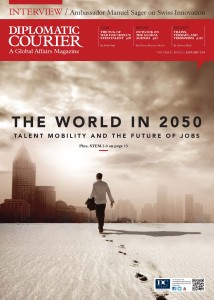 Announcing the January/February 2014 Issue I, Vol VIII
Announcing the January/February 2014 Issue I, Vol VIII
Cover Story: The World in 2050: Talent Mobility and the Future of Jobs
Featured: The Tug of War for China's STEM Talent
PLUS: Ambassador Manuel Sager on Swiss Innovation; STEM 2.0; Outlook on the Global Agenda; and more!
Washington, DC: In an article for the G20 Summit magazine (produced by Diplomatic Courier), Kris Gopalakrishnan wrote that businesses and governments across the world are just now beginning to come to terms with the new reality of the post-crisis era. Unlike previous crises, success will be determined not only by the availability of financial capital but increasingly, human capital. This emerging global war for talent involves three key issues: changing demographic profiles, technology development and consequent productivity increase, and skill gaps and demand-supply mismatches. Mr. Gopalakrishnan’s predictions at the Los Cabos Summit in 2012 were spot on. Today, we are dealing with a paradox: 200 million people unemployed worldwide—40 million in the advanced economies and 75 million of which are youth—and global companies still have millions of unfilled positions.
We asked Mr. Gopalakrishan to reflect on these issues vis-à-vis youth. His piece on youth unemployment expands on his thoughts on global talent mobility offering a fresh perspective on the issue that plagues most governments in the world today. Then we took these concepts and invited industry and thought leaders at a pre-Davos conference in Washington, DC to discuss how global businesses are working to address these issues to build a workforce for the world of the future. We have embarked on the first of many Global Summits this year exploring innovation, talent mobility, and STEM education. We are proud to convene leaders from the OECD, Wal-Mart, Deloitte, the U.S. Chamber of Commerce, Tata Consultancy Services, PepsiCo and many others. At the heart of the employment and talent discussion is an emerging trend facilitated by the development of technology and the Internet. We’ve coined it the Gig Economy and it is a workforce evolution. Since the global financial crisis commenced in 2008, more and more people have turned to freelancing, which allows them the flexibility to work from home, learn and adapt in their own space, and even make decent earnings. Digital freelancers, according to an Accenture study, represent a growing portion of American workers today—almost 20 percent. Another group, Freelancers Union, puts the figure at 42 million. Other studies show the numbers are growing. The internet and technology developments have made this sector a viable opportunity both for freelancers—who may not be able to find steady employment—and for companies that are able to reduce overall labor costs and attract talent wherever they can find it across the globe. Gig seeking freelancers range from graphic designers to lawyers and in this system they compete with counterparts around the world. It is a fascinating sector to watch as these freelancers have already managed to break down immigration barriers and are employable across borders. In this issue we examine what the future holds for jobs and job creation from the perspectives of business leaders of global companies and top diplomats representing nations that are leading the way in prosperity. Ana C. Rold is Editor-in-Chief and Founder of Diplomatic Courier.

